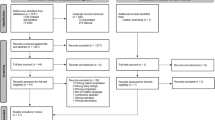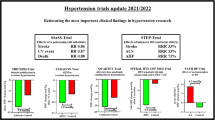Abstract
As Westernised societies have become more affluent, the attitudes of the population have become more risk-aware. People are now intolerant of small risks as well as the physical or mental discomforts from drug side effects. Safety and tolerability are now major forces driving the development of new medicines for the treatment of chronic illnesses and the prevention of increasingly rare events. For example, over the past decades, lower and lower treatment thresholds have been recommended in hypertension. Public perception of risk strongly influences the acceptability of lifetime treatment, especially for mild hypertension. This era has also witnessed great advances in the development of antihypertensive drugs that combine efficacy with unsurpassed tolerability. However, the philosophy of Scottish teachers of Materia medica still appears to be followed—‘never be the first or the last to prescribe a new drug’. Angiotensin-converting enzyme (ACE) inhibitors and angiotensin II receptor antagonists are as safe and as efficacious as other antihypertensive medications and better tolerated. Large trials (HOT, HOPE, UKPDS and PROGRESS) point to the need for rigorous control of blood pressure particularly in high-risk individuals. Antihypertensive drugs that act on the renin–angiotensin system will probably impact significantly on achieving optimal blood pressure levels. Should it not now be accepted that high-risk patients should have ACE inhibitors and angiotensin II receptor antagonists prescribed as first-line agents? We review the evidence for the use of ACE inhibitors and angiotensin II receptor antagonists as antihypertensive agents.
This is a preview of subscription content, access via your institution
Access options
Subscribe to this journal
Receive 12 digital issues and online access to articles
$119.00 per year
only $9.92 per issue
Buy this article
- Purchase on Springer Link
- Instant access to full article PDF
Prices may be subject to local taxes which are calculated during checkout
Similar content being viewed by others
References
Colhoun HM, Dong W, Poulter NR . Blood pressure screening, management and control in England: results from the health survey for England 1994. J Hypertens 1998; 16: 747–572.
Horton R . Future of European cardiology: continentally isolated or globally integrated? Lancet 1999; 354: 791–792.
Murray CJ, Lopez AD . Mortality by cause for eight regions of the world: Global Burden of Disease Study. Lancet 1997; 349: 1269–1276.
Collins R, MacMahon S . Blood pressure, antihyper-tensive drug treatment and the risks of stroke and of coronary heart disease. Br Med Bull 1994; 50: 272–298.
Blood Pressure Lowering Treatment Trialist' Collaboration. Effects of ACE inhibitors, calcium antagonist, and other blood-pressure-lowering drugs: results of prospectively designed overviews of randomised trials. Lancet 2000; 355: 1955–1964.
The sixth report of the Joint National Committee on prevention, detection, evaluation, and treatment of high blood pressure. Arch Intern Med 1997; 157: 2413–2446.
1999 World Health Organization-International Society of Hypertension Guidelines for the Management of Hypertension. Guidelines Subcommittee. J Hypertens 1999; 17: 151–183.
Kaplan NM . Guidelines for the management of hypertension. Can J Cardiol 2000; 16: 1147–1152.
Ramsay L et al. Guidelines for management of hypertension: report of the third working party of the British Hypertension Society. J Hum Hypertens 1999; 13: 569–592.
Scottish Intercollegiate Guidelines Network (SIGN). Hypertension in older people. A national clinical guideline. 2001 SIGN publication no. 49.
Burt VL et al. Prevalence of hypertension in the US adult population. Results from the Third National Health and Nutrition Examination Survey, 1988–1991. Hypertension 1995; 25: 305–313.
Hansson L et al. Effects of intensive blood-pressure lowering and low-dose aspirin in patients with hypertension: principal results of the Hypertension Optimal Treatment (HOT) randomised trial. HOT Study Group. Lancet 1998; 351: 1755–1762.
Nuesch R et al. Relation between insufficient response to antihypertensive treatment and poor compliance with treatment: a prospective case–control study. BMJ 2001; 323: 142–146.
Waeber B, Leonetti G, Kolloch R, McInnes GT . Compliance with aspirin or placebo in the Hypertension Optimal Treatment (HOT) study. J Hypertens 1999; 17: 1041–1045.
Hyman DJ, Pavlik VN . Characteristics of patients with uncontrolled hypertension in the United States. N Engl J Med 2001; 345: 479–486.
Hansson L et al. Randomised trial of old and new antihypertensive drugs in elderly patients: cardiovascular mortality and morbidity the Swedish Trial in Old Patients with Hypertension-2 study. Lancet 1999; 354: 1751–1756.
Hansson L et al. Effect of angiotensin-converting-enzyme inhibition compared with conventional therapy on cardiovascular morbidity and mortality in hypertension: the Captopril Prevention Project (CAPPP) randomised trial. Lancet 1999; 353: 611–616.
The ALLHAT Officers and Coordinators for the ALLHAT Collaborative Research Group. Major cardiovascular events on hypertensive patients randomised to doxazosin vs chlorthalidone. The Antihypertensive and Lipid-Lowering Treatment to Prevent Heart Attack Trial (ALLHAT). JAMA 2000; 283: 1967–1975.
The ALLHAT Officers and Coordinators for the ALLHAT Collaborative Research Group. Major outcomes in high-risk hypertensive patients randomised to angiotensin-converting enzyme inhibitor or calcium channel blocker vs diuretic. The Antihypertensive and Lipid-Lowering Treatment to Prevent Heart Attack Trial (ALLHAT). JAMA 2002; 288: 2981–2997.
Wing LMH et al. A comparison of outcomes with angiotensin-converting-enzyme inhibitors and diuretics for hypertension in the elderly. N Engl J Med 2003; 348: 835–592.
Estacio RO et al. The effect of nisoldipine as compared with enalapril on cardiovascular outcomes in patients with non-insulin-dependent diabetes and hypertension. N Engl J Med 1998; 338: 645–652.
Tatti P et al. Outcome results of the Fosinopril Versus Amlodipine Cardiovascular Events Randomized Trial (FACET) in patients with hypertension and NIDDM. Diabetes Care 1998; 21: 597–603.
Pahor M et al. Therapeutic benefits of ACE inhibitors and other antihypertensive drugs in patients with type 2 diabetes. Diabetes Care 2000; 23: 888–892.
Lewis EJ, Hunsicker LG, Bain RP, Rohde RD . The effect of angiotensin-converting-enzyme inhibition on diabetic nephropathy. The Collaborative Study Group. N Engl J Med 1993; 329: 1456–1462.
HOPE (Heart Outcomes Prevention Evaluation) Study Investigators. Effects of an angiotensin-converting-enzyme inhibitor, ramipril, on cardiovascular events in high-risk patients. N Engl J Med 2000; 342: 145–153.
PROGRESS Collaborative Group. Randomised trial of a perindopril-based blood-pressure-lowering regimen among 6,105 individuals with previous stroke or tra-nsient ischaemic attack. Lancet 2001; 358: 1033–1041.
Kober L et al. A clinical trial of the angiotensin-converting-enzyme inhibitor trandolapril in patients with left ventricular dysfunction after myocardial infarction. Trandolapril Cardiac Evaluation (TRACE) Study Group. N Engl J Med 1995; 333: 1670–1676.
Cleland JG et al. Effect of ramipril on morbidity and mode of death among survivors of acute myocardial infarction with clinical evidence of heart failure. A report from the AIRE Study Investigators. Eur Heart J 1997; 18: 41–51.
Gerstein HC et al. Albuminuria and risk of cardiovascular events, death, and heart failure in diabetic and nondiabetic individuals. JAMA 2001; 286: 421–426.
Schrier RW, Estacio RO . The effect of angiotensin-converting enzyme inhibitors on the progression of nondiabetic renal disease: a pooled analysis of individual-patient data from 11 randomized, controlled trials. Ann Intern Med 2001; 135: 138–139.
Stergiou GS et al. Does the antihypertensive response to angiotensin converting enzyme inhibition predict the antihypertensive response to angiotensin receptor antagonism? Am J Hypertens 2001; 14: 688–693.
Fogari R et al. Sexual activity in hypertensive men treated with valsartan or carvedilol: a crossover study. Am J Hypertens 2001; 14: 27–31.
Llisterri JL et al. Sexual dysfunction in hypertensive patients treated with losartan. Am J Med Sci 2001; 321: 336–341.
Agodoa LY et al. Effect of ramipril vs amlodipine on renal outcomes in hypertensive nephrosclerosis: a ran-domized controlled trial. JAMA 2001; 285: 2719–2728.
Dahlof B et al. Cardiovascular morbidity and mortality in the Losartan Intervention For Endpoint reduction in hypertension study (LIFE): a randomised trial against atenolol. Lancet 2002; 359: 995–1003.
Lindholm LH et al. Cardiovascular morbidity and mortality in patients with diabetes in the Losartan Intervention For Endpoint reduction in hypertension study (LIFE): a randomised trial against atenolol. Lancet 2002; 359: 1004–1010.
Yusuf S et al. Beta blockade during and after myocardial infarction: an overview of the randomized trials. Prog Cardiovasc Dis 1985; 27: 335–371.
Pitt B et al. Effect of losartan compared with captopril on mortality in patients with symptomatic heart failure: randomised trial—the Losartan Heart Failure Survival Study ELITE II. Lancet 2000; 355: 1582–1587.
Cohn JN . Improving outcomes in congestive heart failure: Val-HeFT. Valsartan in Heart Failure Trial. Cardiology 1999; 91(Suppl 1): 19–22.
Mann J, Julius S . The Valsartan Antihypertensive Long-term Use Evaluation (VALUE) trial of cardio-vascular events in hypertension. Rationale and design. Blood Press 1998; 7:176–183.
Brenner BM et al. Effects of losartan on renal and cardiovascular outcomes in patients with type 2 diabetes and nephropathy. N Engl J Med 2001; 345: 861–869.
Parving HH et al. The effect of irbesartan on the development of diabetic nephropathy in patients with type 2 diabetes. N Engl J Med 2001; 345: 870–878.
Lewis EJ et al. Renoprotective effect of the angiotensin-receptor antagonist irbesartan in patients with nephropathy due to type 2 diabetes. N Engl J Med 2001; 345: 851–860.
Mogensen CE et al. Randomised controlled trial of dual blockade of renin–angiotensin system in patients with hypertension, microalbuminuria, and non-insulin dependent diabetes: the candesartan and lisinopril microalbuminuria (CALM) study. BMJ 2000; 321: 1440–1444.
Viberti G, Wheeldon NM . MicroAlbuminuria Reduction With VALsartan (MARVAL) Study Investigators. Microalbuminuria reduction with valsartan in patients with type 2 diabetes mellitus: a blood pressure-independent effect. Circulation 2002; 106: 672–678.
Schrier RW et al. Appropriate Blood pressure Control in Diabetes-part 2 with Valsartan (ABCD-2V trial). Am J Hypertens 1999; 12: 141A.
Dickstein K, Kjekshus J . OPTIMAAL Steering Committee of the OPTIMAAL Study Group. Effects of losartan and captopril on mortality and morbidity in high-risk patients after acute myocardial infarction: the OPTIMAAL randomised trial. Optimal Trial in Myocardial Infarction with Angiotension II Antagonist Losartan. Lancet 2002; 360: 752–760.
Pfeffer MA et al. Valsartan in acute myocardial infarction trial (VALIANT): rationale and design. Am Heart J 2000; 140: 727–750.
Argenziano L, Trimarco B . Effect of eprosartan and enalapril in the treatment of elderly hypertensive patients: subgroup analysis of a 26-week, double-blind, multicentre study. Eprosartan Multi-national Study Group. Curr Med Res Opin 1999; 15: 9–14.
Lichtenstein DR, Wolfe MM . COX-2-selective NSAIDs: new and improved? JAMA 2000; 284: 1297–1299.
Freemantle N . Interpreting the results of secondary end points and subgroup analyses in clinical trials: should we lock the crazy aunt in the attic? BMJ 2001; 322: 989–991.
Randomised trial of cholesterol lowering in 4444 patients with coronary heart disease: the Scandinavian Simvastatin Survival Study (4S). Lancet 1994; 344: 1383–1389.
Shepherd J et al. Prevention of coronary heart disease with pravastatin in men with hypercholesterolemia. West of Scotland Coronary Prevention Study Group. N Engl J Med 1995; 333: 1301–1307.
Author information
Authors and Affiliations
Corresponding author
Rights and permissions
About this article
Cite this article
Wong, S., McInnes, G. & MacDonald, T. Why not prescribe the best drugs for hypertension now?. J Hum Hypertens 17, 505–511 (2003). https://doi.org/10.1038/sj.jhh.1001576
Received:
Revised:
Accepted:
Published:
Issue Date:
DOI: https://doi.org/10.1038/sj.jhh.1001576
Keywords
This article is cited by
-
A simplified antihypertensive drug regimen does not ameliorate control of childhood hypertension
Journal of Human Hypertension (2005)
-
LIFE and SCOPE: what guidance do they offer alongside ALLHAT and ANBP2?
Journal of Human Hypertension (2004)



